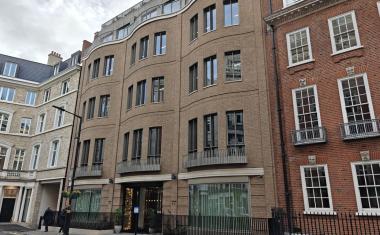Collaboration with Assa Abloy Helps Achieve LEED Gold Certification For a New Manufacturing Plant
Improving sustainability performance is becoming a higher priority for building developers, owners and users. One consequence is fast-growing demand for green building certifications — and therefore specification. Specialist input can make the difference between hitting and missing a project target.
As experts in industrial design and construction, GBPBP PROJPRZEM were engaged by multinational Phillips-Medisize to create and execute the concept for a major new facility outside Katowice in southern Poland. It became the latest of around 5,000 construction projects overseen by GBPBP since it was founded in 1948.
Part of the project brief was to gain LEED certification for this new manufacturing plant. To help achieve this goal, they sought specialist BIM and specification support from the early design phase right through to project completion — including for the building’s door and security and access solutions which also impact the award process.
Expertise in relevant materials and the documentation required to receive LEED credits was critical: “We knew that Assa Abloy had the knowledge and the access and security solutions dedicated to sustainable buildings,” explains Wojciech Szmyd at GBPBP PROJPRZEM.
Assa Abloy: expertise in sustainable design
GBPBP PROJPRZEM partnered with Assa Abloy Opening Solutions over the course of the project. This collaboration formed part of a BIM approach which GBPBP have long used to connect architects, civil engineers and installers within one transparent environment — to enable fast, accurate, cost-efficient project delivery.
A dedicated BIM consultant at Assa Abloy helped ensure the entire door specification process was efficient and effective. One key collaboration tool was the Openings Studio software plugin for Revit, which enabled specification changes to quickly and accurately populate the evolving building design.
The same tool also enabled transparent communication between the project coordinators and other stakeholders. Everyone was always working with accurate, up-to-date information.
This close collaboration — and the flexibility of Openings Studio — were critical in helping the team to overcome a major issue related to low-voltage designs. Any changes are handled quickly and efficiently by the software: “When it was necessary to revise the project, I made another analysis and after that received the corrected specification,” adds Wojciech Szmyd “I was supported throughout the entire design and construction period.”
One-stop-shop for door and opening solutions
The vast portfolio of available Assa Abloy door and access solutions was another major benefit. “We were looking for a supplier who would be able to support us at the project preparation phase with a rich product portfolio, comprehensive knowledge of door structure and its use at passages with a specific function; for instance, evacuation or fire protection,” he says.
Assa Abloy supplied a broad range of products and solutions including around 180 ALPE doors for various specialist applications around the facility; effeff electric strikes; rack-and-pinion door closers; mechanical security locks; and more.
The availability of these varied solutions, as well as documentation such as detailed Environmental Product Declarations (EPDs) is supporting Phillips-Medisize throughout their application process for the targeted LEED award of Gold.
To learn how Assa Abloy BIM and Specification consultants can help your project achieve green building certification, download the brochure.















